Abstract
ISU's intermediate energy nuclear physics group is presently involved in several fundamental physics measurements. This talk will describe a program to measure the fractional polarization of down quarks in a nucleon using polarized electrons to probe polarized nucleon targets. Quantum chromodynamcs (QCD) is a theory of the strong interaction; one of the four fundamental forces in nature. QCD predicts that the down quark will carry all of the nucleon's spin and result in a fractional polarization of unity when the probe interacts with down quarks that carry all of the nucleon's momentum. This theory contradicts the leading constituent quark model of the nucleon. The world's current data set is unable to discriminate between QCD's prediction and the constituent quark model. A description of this experimental program and the roles of ISU graduate students will be described.
electron scattering (collisions)
Elastic Collisions: Conserve P and E
Inelastic : Only Conserve P
Four Momentum
Using Ryder 4-momentum tensor convention: [math]P_{\mu} \equiv (E/c, -\vec{p}) \;\;\;\;\; P^{\mu} \equiv (E/c, \vec{p})[/math]
If I take the inner product of a particles four momentum with itself I get
[math]P_{\mu} P^{\mu} \equiv \left | \vec P \right |^2 = \left ( \frac{E}{c} \right )^2 - \vec{p} \cdot \vec{p} [/math]
The Energy-Momentum relation
- [math]E^2 = (pc)^2 + (m_0c^2)^2[/math]
- [math]\Rightarrow P_{\mu} P^{\mu} = \left ( \frac{E}{c} \right )^2 - \vec{p} \cdot \vec{p} = (m_0c)^2[/math]
The [math]\omega[/math] and [math]\vec k[/math] are the reciprocal quantities to [math]t[/math] and [math]\vec r[/math]
- [math](t,\vec r) \rightarrow (\omega, \vec k)[/math]
For a plane wave
[math]K^{\mu} \equiv (\omega, \vec k)[/math]
Similarly
- [math]\Rightarrow K_{\mu} K^{\mu} = \left ( \omega \right )^2 - \vec{k} \cdot \vec{k} [/math]
The de Broglie relation [math]( p = \frac{h}{\lambda} )[/math]
- [math]P_{\mu} = \hbar K_{\mu}[/math]
- [math]\Rightarrow K_{\mu}K^ {\mu}=\frac{P_{\mu}P^{\mu} }{ \hbar } = [/math]
- [math]\left ( \omega \right )^2 - \vec{k} \cdot \vec{k} = (m_0c)^2[/math]
if its a massless particle (photon) then [math]m_0 = 0[/math]
- [math]\left ( \omega \right )^2 = \vec{k} \cdot \vec{k} [/math]
Definition of Momentum Transfer
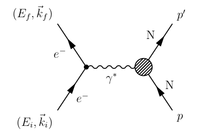
[math]q_\mu \equiv (\omega, \vec{q})[/math]
[math]k^i_\mu \equiv (E_i, \vec{k_i})[/math]
[math]k^f_\mu \equiv (E_f, \vec{k_f})[/math]
- Conservation of Momentum
- [math] k^i_\mu =q_\mu + k^f_\mu [/math]
- Momentum Transfer
- [math] q_\mu =k^i_\mu - k^f_\mu [/math]
- Momentum Transfer Squared
- [math] -Q^2 = q^2 = q_\mu q^{\mu} =(E_i-E_f)^2 - (\vec{k}_i - \vec{k}_f) \cdot (\vec{k}_i - \vec{k}_f) [/math]
- [math]= m_i^2 + m_f^2 -2E_iE_f + 2\left | \vec{k}_i\right | \left | \vec{k}_f\right | cos(\theta)[/math]
- [math]=-4E_iE_f \sin^2(\theta/2) \;\;\; m_i = m_f \ll E_i \mbox{ and } E \approx \left | \vec{k}_i\right |[/math]
- [math]Q^2 =4E_iE_f \sin^2(\theta/2) \gt 0[/math] A space-like scattering event
Space-like interval: Two events are separated by a space like interval then there isn't enough time passing between them to allow a cause-effect relationship because a photon can't traverse the distance. This means that there is no reference frame that may be used to describe the event as happening at the same spatial location but there is a frame that describes them happening at the same time. If the spacetime interval between the two events is defined as s[math]^2 = (\Delta r)^2 - (c\Delta t)^2[/math] then [math]s^2 \gt 0[/math] for a space-like interval
Time-like interval: Two events are separated by a time like interval if enough time passes between them to allow a cause-effect relationship. This means that there is no reference frame that may be used to describe the event as happening at the same time but there is one that describes them happening at the same spatial location. If the spacetime interval between the two events is defined as s[math]^2 = (\Delta r)^2 - (c\Delta t)^2[/math] then [math]s^2 \lt 0[/math] for a time-like interval
4-Momentum vector definition using Ryder convention
- [math]P_{\mu} \equiv \left ( \frac{E}{c} , - \vec p \right )[/math]
- [math]P^{\mu} \equiv \left ( \frac{E}{c} , \vec p \right )[/math]
- [math]P_{\mu} P^{\mu} = \left ( \frac{E}{c}\right )^2 - \vec p^2 = E^2-p^2 = m^2[/math] if you define the speed of light as unity
- Note
- Other conventions used by Perkins
- [math]P_{\mu} \equiv \left ( \vec p, -E \right )[/math]
- [math]P^{\mu} \equiv \left ( \vec p , E\right )[/math]
or Kollen
- [math]P_{\mu} \equiv \left ( \vec p, iE \right )[/math]
- [math]P^{\mu} \equiv \left ( \vec p , iE\right )[/math]
Momentum transfer is defined as
- [math]q_{\mu} \equiv ( \omega, \vec q) = P^i_{\mu} - P^f_{\mu}[/math] : conservation of momentum
- [math]q_{\mu}q^{\mu} = (E_i - E_f)^2 - (\vec {P}_i - \vec{P}_f) \cdot (\vec {P}_i - \vec{P}_f)[/math]
- [math]= m_i^2 +m_f^2 - 2E_iE_f + 2 \left | \vec {P}_i \right | \left | \vec {P}_f \right |[/math]
Definition of Missing Mass
Inelastic scattering (Energy is not conserved but absorbed from the momentum transfer)
[math]P_e^{\mu} \equiv (E_i,\vec{k}_i)[/math]
[math]\left(P_e^{\mu}\right)^{\prime} \equiv (E_f,\vec{k}_f)[/math]
[math]P_p^{\mu} \equiv (M_p,0)[/math]
[math]\left(P_p^{\mu}\right)^{\prime} \equiv (E_X,\vec{k}_X)[/math]
- 4-momentum conservation
- [math]P_e^{\mu} + P_p^{\mu} = \left(P_e^{\mu}\right)^{\prime} + \left(P_p^{\mu}\right)^{\prime}[/math]
[math]\left(P_p^{\mu}\right)^{\prime} \left(P_{\mu}^p\right)^{\prime} = [P_e^{\mu} + P_p^{\mu} - \left(P_e^{\mu}\right)^{\prime} ][P^e_{\mu} + P^p_{\mu} - \left(P^e_{\mu}\right)^{\prime} ][/math]
[math]E_X^2 - P_X^2 \equiv W^2 = (E_i^2 - k_i^2) + (E_f^2-k_f^2) + M_p^2 + 2M_p(E_i - E_f) -2(E_iE_f-\vec{k_i}\cdot \vec{k_f})[/math]
- [math](E_i^2 - k_i^2) + (E_f^2-k_f^2)= 2m_e^2 \lt \lt M_p^2[/math]
[math]W^2 = M_p^2 + 2M_p(E_i - E_f) -2(E_iE_f-\vec{k_i}\cdot \vec{k_f})[/math]
- [math]W^2=M_p^2 + 2M_p(E_i-E_f) -Q^2 \equiv [/math]Invariant Missing Mass = mass of the intermediate state that was created.
200 px
The Delta Resonance
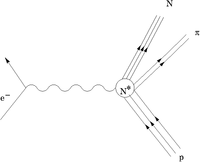
Decay Modes: [math]ep \rightarrow \;\; \left \{ {N \pi \;\;\; 99.5% \atop p \gamma \;\;\; 0.5% } \right .[/math]
[math]\sigma = \lt \Delta^+ | V_{\mu}^3| p\gt [/math]
- [math]V_{\mu}^3 =[/math] Vector current of the virtual photon exchange
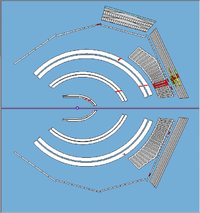
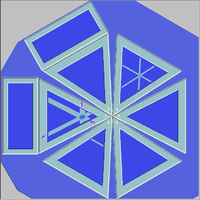
Spin 1/2 and 3/2 final states
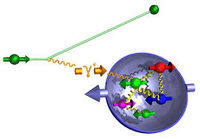
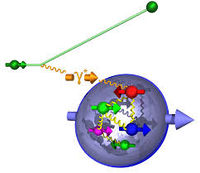
Double Spin Asymmetry
If both the target and the incident virtual photon are polarized then one can measure the cross-section for two separate conditions; when the spins are parallel and anti-parallel.
Let
[math]\sigma_{3/2} [/math]
- [math]\sigma_{1/2} \equiv[/math] photon helicity is anti-parallel to the target spin
- [math]\sigma_{3/2} \equiv[/math] photon helicity is parallel to the target spin.
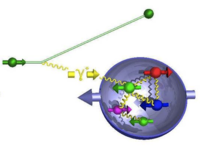 |
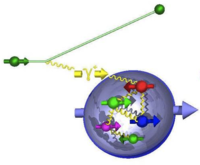
|
| [math]\sigma_{\frac{1}{2}}[/math](Struck quark spin is [math]\parallel[/math] to Nucleon spin) |
[math]\sigma_{\frac{3}{2}}[/math] (Struck quark spin is [math]\not\parallel[/math] to Nucleon spin)
|
Clebsch Gordan recoupling
The recoupling of two subsystems [math]\psi[/math] with angular momenta [math]j_1[/math] and [math]j_2[/math] to a new system[math] \Psi[/math] with total angular momentum [math]J[/math] is written as
[math]\Psi^{J}_{M} = \sum_{m_1=-j_1}^{j_1} \sum_{m_2=-j_2}^{j_2} C^{j_1\;,\;j_2,\;\;J}_{m_1,m_2,M} \; \psi^{j_1}_{m_1} \psi^{j_2}_{m_2}[/math] = expansion of the systems total angular momentum in terms of the uncoupled original basis states of each individual constituent
[math]\Psi^{3/2}_{3/2} = \sum_{m_1,m_2} C^{1,1/2,3/2}_{m_1,m_2,3/2} \psi^{1}_{m_1} \psi^{1/2}_{m_2} = C^{1,\frac{1}{2},\frac{3}{2}}_{1,\frac{1}{2},\frac{3}{2}}\psi^{1}_{1} \psi^{1/2}_{1/2} [/math] : all other possible m_1 and m_2 values don't add to M
[math]\Psi^{3/2}_{1/2} = \sum_{m_1,m_2} C^{1,1/2,3/2}_{m_1,m_2,1/2} \psi^{1}_{m_1} \psi^{1/2}_{m_2} = C^{1,\frac{1}{2},\frac{3}{2}}_{0,\frac{1}{2},\frac{1}{2}}\psi^{1}_{0} \psi^{1/2}_{1/2} + C^{1,\frac{1}{2},\frac{3}{2}}_{1,\frac{-1}{2},\frac{1}{2}}\psi^{1}_{1} \psi^{1/2}_{-1/2}[/math] : all other possible m_1 and m_2 values don't add to M
If I constrain the helicity of my virtual photon to be +1 by preparing electrons with spins along their direction of motion, then the state [math]\psi^{1}_{0}[/math] doesn't exist so only only one state enters the sum

[math]\Psi^{3/2}_{1/2} = C^{1,\frac{1}{2},\frac{3}{2}}_{1,\frac{-1}{2},\frac{1}{2}}\psi^{1}_{1} \psi^{1/2}_{-1/2}[/math] : all other possible m_1 and m_2 values don't add to M
[math]C^{j_1,j_2,J}_{m_1,m_2,M}[/math] : Clebsch-Gordon Coefficient
[math]C^{1,\frac{1}{2},\frac{3}{2}}_{1,\frac{1}{2},\frac{3}{2}}=1[/math]
[math]C^{1,\;\;\frac{1}{2},\frac{3}{2}}_{1,-\frac{1}{2},\frac{1}{2}}= \frac{1}{\sqrt{3}}[/math]
[math]A = \frac{\sigma_{\frac{1}{2}} - \sigma_{\frac{3}{2}}}{\sigma_{\frac{1}{2}} + \sigma_{\frac{3}{2}}} = \frac{\frac{1}{3} - 1}{\frac{1}{3} + 1} = -1/2[/math]
Quark Distributions
- [math]\sigma_p^{\pi^+ \pm \pi^-} = \frac{1}{9}[4( u + \bar{u}) \pm ( d + \bar{d})]D_u^{\pi^+ \pm \pi^-}[/math]
- [math]\sigma_n^{\pi^+ \pm \pi^-} = \frac{1}{9}[4(d + \bar{d}) \pm (u + \bar{u})]D_u^{\pi^+ \pm \pi^-}[/math]
- [math]\sigma_{2H}^{\pi^+ \pm \pi^-} = \frac{5}{9}[( u + \bar{u}) \pm ( d + \bar{d})]D_u^{\pi^+ \pm \pi^-}[/math]
The polarized distributions may be expressed in a similar fashion:
 |

|
| [math]\sigma_{\frac{1}{2}}[/math](Struck quark spin is [math]\parallel[/math] to Nucleon spin) |
[math]\sigma_{\frac{3}{2}}[/math] (Struck quark spin is [math]\not\parallel[/math] to Nucleon spin)
|
[math]\frac{d^3 \sigma^h_{1/2}}{dxdQ^2 dz}\approx \Sigma_q e_q^2 q^{\parallel}(x,Q^2)D_q^h(z,Q^2)[/math]
[math]\frac{d^3 \sigma^h_{3/2}}{dxdQ^2 dz}\approx \Sigma_q e_q^2 q^{\not\parallel}(x,Q^2)D_q^h(z,Q^2)[/math]
- [math]\frac{d^3 \sigma^h_{1/2(3/2)}}{dxdQ^2 dz}\approx \Sigma_q e_q^2 q^{+(-)}(x,Q^2)D_q^h(z,Q^2)[/math]
[math]\Delta \sigma_p^{\pi^+ \pm \pi^-} = \frac{1}{9}[4(\Delta u + \Delta \bar{u}) \pm (\Delta d + \Delta \bar{d})]D_u^{\pi^+ \pm \pi^-}[/math]
- [math]\Delta \sigma_n^{\pi^+ \pm \pi^-} = \frac{1}{9}[4(\Delta d + \Delta d^-) \pm (\Delta u + \Delta u^-)]D_u^{\pi^+ \pm \pi^-}[/math]
- [math]\Delta \sigma_{2H}^{\pi^+ \pm \pi^-} = \frac{5}{9}[(\Delta u + \Delta \bar{u}) \pm (\Delta d + \Delta \bar{d})]D_u^{\pi^+ \pm \pi^-}[/math]
Duality
- [math]\lt g_1\gt equiv \frac{\int_{x_l}^{x_h} g_1(x,Q^2) dx}{x_h - x_l}[/math]
where
[math]x= \frac{1}{1 + \frac{W^2-M^2}{Q^2}[/math]
x_l (x_h) is the maximum (minimum) value of x for the interval of W being considered
Polarized QUark distributions
Delta d-over d
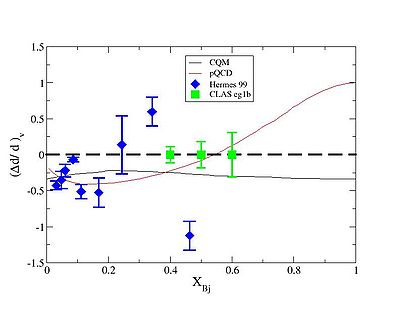 [math]X_{Bj}[/math] vs [math]\frac{\Delta d_v}{d_v}[/math] |
References
Past colloquia
TF_01092012_Colloq
Theory
Phenomenological
NP, B291(1987)793; NP, B346(1990)1;
Z. Phys. C56(1992)493;
Eur. Phys. J. C44 (2005)219;
hep-ph/0205123
arXiV:1310.5285
QCD inspired
NP, B483(1997)291; NP, B484(1997)265;
PRL 85(2000)3591; PRL 89(2002)162301;
JHEP 0211(2002)44; NP, A720(2003)131;
Eur. Phys. J. C30(2003)213; arXiV:09073534;
NP, A761(2005)67; PR, C81(2010)024902
Hybrids
PYTHIA + BUU simulation
PR, C70(2004)054609; NP, A801(2008)68
Experiment
keith's 2012 talk in Italy on EG1-DVCS
Unpolarized
http://link.springer.com/article/10.1007%2FJHEP04%282014%29005
File:AndyMiller 200TalkAtDESY.pdf 2002 talk by CA Miller at DESY
File:Dueren.98.055.pdf 1998 Duren talk
2013 APS talk on EG1-DVCS
July 30,2014 talk by XingLong Li at Heremes
File:XingLongLi TalkOnPACIAEmdoelForSIDIS.pdf
from
http://www.google.com/url?sa=t&rct=j&q=&esrc=s&source=web&cd=31&ved=0CB0QFjAAOB4&url=http%3A%2F%2Fhadron2014.csp.escience.cn%2Fdct%2Fattach%2FY2xiOmNsYjpwZGY6MzAwMjA%3D&ei=UPw1VNiQAdHlsATA7IHwDw&usg=AFQjCNH5yyek_zTJ22TZq0Dw_YLUeAxe2Q
Xiangs proposal for CLAS12 measurement of SIDIS Xsections see Fig. 1
Semi-inclusive deep inelastic scattering at small transverse momentum
Naomi's SIDIS Hermes talk from 2011 at NNPSS11
1986 article ob QCD effects in semi-inclusive deep inelastic scattering from a polarized target by P. Chiappetta J. -Ph. Guillet
theses
2014 Ph.D thesis of Naomi's student Sylvester Joosten
http://www.google.com/url?sa=t&rct=j&q=&esrc=s&source=web&cd=7&cad=rja&uact=8&ved=0CFYQFjAG&url=http%3A%2F%2Fwww.nikhef.nl%2Fpub%2Fservices%2Fbiblio%2Ftheses_pdf%2Fthesis_E_Garutti.pdf&ei=Osw3VJbSAY27ogSx3IDwDQ&usg=AFQjCNENlNdgPr6dgfq9OanlL8cUnYHmMQ&bvm=bv.77161500,d.cGU
TF_SIDIS_Physics











